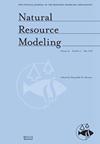全球环境多尺度模式(GEM)对伊朗降水和温度的客观评价
IF 2.1
4区 环境科学与生态学
Q3 ENVIRONMENTAL SCIENCES
引用次数: 0
摘要
全球环境多尺度模型(GEM)目前正在运行中,用于25-15年的数据同化和预测 km尺度;区域10 北美上空公里尺度;和2.5 公里,覆盖加拿大。为了评估GEM模型在伊朗的预测应用,GEM在25 km尺度与水文气象站的数据集进行了比较,并使用De Martonne气候分类方法划定了气候带进行比较。GEM模型的输出与每个区域的观测结果进行了比较。结果表明,GEM输出与测得的日温度之间具有良好的一致性,干旱地区的Kling‐Gupta效率为0.76,半干旱地区为0.71,潮湿地区为0.78。GEM产量和测得的年降水量之间也存在一致性,干旱地区差异为50%,半干旱地区为36%,湿润地区为15%。站点的高程与相应GEM网格单元的平均高程之间存在~13%的系统差异;与强迫数据集相关的高程差异可以潜在地使用环境衰减率来校正。与水文气象数据集相比,GEM模型的降水量输出不如温度输出准确,这可能会影响伊朗利用GEM进行潜在预测的准确性。这项研究的结果使我们了解了GEM模型在气候变化和水文气候研究中的操作和局限性。本文章由计算机程序翻译,如有差异,请以英文原文为准。
Objective evaluation of the Global Environmental Multiscale Model (GEM) with precipitation and temperature for Iran
The Global Environmental Multiscale Model (GEM) is currently in operational use for data assimilation and forecasting at 25–15 km scales; regional 10 km scales over North America; and 2.5 km scales over Canada. To evaluate the GEM model for forecasting applications in Iran, global daily temperature and precipitation outputs of GEM at a 25 km scale were compared to data sets from hydrometeorological stations and the De Martonne climate classification method was used to demarcate climate zones for comparisons. GEM model outputs were compared to observations in each of these zones. The results show good agreement between GEM outputs and measured daily temperatures with Kling‐Gupta efficiencies of 0.76 for the arid, 0.71 for the semiarid, and 0.78 for the humid regions. There is also an agreement between GEM outputs and measured annual precipitation with differences of 50% for the arid, 36% for the semiarid, and 15% for the humid region. There is a ~13% systematic difference between the elevation of stations and the average elevation of corresponding GEM grid cells; differences in elevation associated with forcing data sets can be potentially corrected using environmental lapse rates. Compared with hydrometeorological data sets, the GEM model precipitation outputs are less accurate than temperature outputs, and this may influence the accuracy of potential Iranian forecasting operations utilizing GEM. The results of this study provide an understanding of the operation and limitations of the GEM model for climate change and hydro‐climatological studies.
求助全文
通过发布文献求助,成功后即可免费获取论文全文。
去求助
来源期刊

Natural Resource Modeling
环境科学-环境科学
CiteScore
3.50
自引率
6.20%
发文量
28
审稿时长
>36 weeks
期刊介绍:
Natural Resource Modeling is an international journal devoted to mathematical modeling of natural resource systems. It reflects the conceptual and methodological core that is common to model building throughout disciplines including such fields as forestry, fisheries, economics and ecology. This core draws upon the analytical and methodological apparatus of mathematics, statistics, and scientific computing.
 求助内容:
求助内容: 应助结果提醒方式:
应助结果提醒方式:


